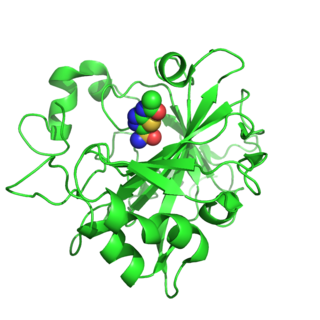
MECP2 is a gene that encodes the protein MECP2. MECP2 appears to be essential for the normal function of nerve cells. The protein seems to be particularly important for mature nerve cells, where it is present in high levels. The MECP2 protein is likely to be involved in turning off several other genes. This prevents the genes from making proteins when they are not needed. Recent work has shown that MECP2 can also activate other genes. The MECP2 gene is located on the long (q) arm of the X chromosome in band 28 ("Xq28"), from base pair 152,808,110 to base pair 152,878,611.

ADGRV1, also known as G protein-coupled receptor 98 (GPR98) or Very Large G-protein coupled receptor 1 (VLGR1), is a protein that in humans is encoded by the GPR98 gene. Several alternatively spliced transcripts have been described.

Probable G-protein coupled receptor 22 is a protein that in humans is encoded by the GPR22 gene.

Roundabout homolog 1 is a protein that in humans is encoded by the ROBO1 gene.

Ephrin A3 is a protein that in humans is encoded by the EFNA3 gene.

Leucine-rich repeat-containing protein 4 is a protein that in humans is encoded by the LRRC4 gene.

Neuronal membrane glycoprotein M6-b is a protein that in humans is encoded by the GPM6B gene.

Roundabout homolog 2 is a protein that in humans is encoded by the ROBO2 gene.

Transcription factor SOX-8 is a protein that in humans is encoded by the SOX8 gene.

Syntabulin, also known as SYBU, is a human gene.

Netrin receptor UNC5C is a protein that in humans is encoded by the UNC5C gene.

Carbonic anhydrase 14 is an enzyme that in humans is encoded by the CA14 gene.

Neurexophilin-1 is a protein that in humans is encoded by the NXPH1 gene.

Netrin-G2 is a protein that in humans is encoded by the NTNG2 gene.

Netrin receptor UNC5A is a protein that in humans is encoded by the UNC5A gene.

Glycine receptor subunit alpha-2 is a protein that in humans is encoded by the GLRA2 gene.

Bardet–Biedl syndrome 10, also known as BBS10 is a human gene.

Asc-type amino acid transporter 1 (Asc-1) is a protein that in humans is encoded by the SLC7A10 gene.

Guanine nucleotide-binding protein G(t) subunit alpha-3, also known as gustducin alpha-3 chain, is a protein subunit that in humans is encoded by the GNAT3 gene.

FYVE, RhoGEF and PH domain-containing protein 2 (FGD2), also known as zinc finger FYVE domain-containing protein 4 (ZFYVE4), is a protein that in humans is encoded by the FGD2 gene.




















